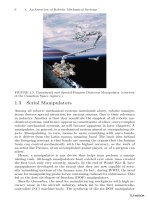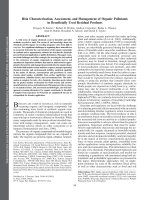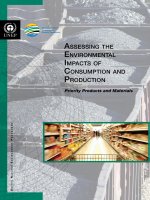SINTERING – METHODS AND PRODUCTS pdf
Bạn đang xem bản rút gọn của tài liệu. Xem và tải ngay bản đầy đủ của tài liệu tại đây (28.32 MB, 326 trang )
SINTERING – METHODS
AND PRODUCTS
Edited by Volodymyr Shatokha
Sintering – Methods and Products
Edited by Volodymyr Shatokha
Published by InTech
Janeza Trdine 9, 51000 Rijeka, Croatia
Copyright © 2012 InTech
All chapters are Open Access distributed under the Creative Commons Attribution 3.0
license, which allows users to download, copy and build upon published articles even for
commercial purposes, as long as the author and publisher are properly credited, which
ensures maximum dissemination and a wider impact of our publications. After this work
has been published by InTech, authors have the right to republish it, in whole or part, in
any publication of which they are the author, and to make other personal use of the
work. Any republication, referencing or personal use of the work must explicitly identify
the original source.
As for readers, this license allows users to download, copy and build upon published
chapters even for commercial purposes, as long as the author and publisher are properly
credited, which ensures maximum dissemination and a wider impact of our publications.
Notice
Statements and opinions expressed in the chapters are these of the individual contributors
and not necessarily those of the editors or publisher. No responsibility is accepted for the
accuracy of information contained in the published chapters. The publisher assumes no
responsibility for any damage or injury to persons or property arising out of the use of any
materials, instructions, methods or ideas contained in the book.
Publishing Process Manager Sasa Leporic
Technical Editor Teodora Smiljanic
Cover Designer InTech Design Team
First published March, 2012
Printed in Croatia
A free online edition of this book is available at www.intechopen.com
Additional hard copies can be obtained from
Sintering – Methods and Products, Edited by Volodymyr Shatokha
p. cm.
ISBN 978-953-51-0371-4
Contents
Preface IX
Part 1 Sintering Technologies and Methods 1
Chapter 1 Latest Generation Sinter
Process Optimization Systems 3
Thomas Kronberger, Martin Schaler
and Christoph Schönegger
Chapter 2 Modeling Sintering Process of Iron Ore 23
Jose Adilson de Castro
Chapter 3 Development of Sintered MCrAlY
Alloys for Aeronautical Applications 47
Fernando Juárez López and Ricardo Cuenca Alvarez
Chapter 4 Metal Laser Sintering for Rapid Tooling
in Application to Tyre Tread Pattern Mould 73
Jelena Milovanovic, Milos Stojkovic
and Miroslav Trajanovic
Chapter 5 Sintering of Supported Metal Catalysts 91
José Luis Contreras
and
Gustavo A. Fuentes
Chapter 6 Sintering Characteristics of Injection
Moulded 316L Component Using
Palm-Based Biopolymer Binder 127
Mohd Afian Omar and Istikamah Subuki
Chapter 7 Liquid Phase Sintering of Fe-Cu-Sn-Pb
System for Tribological Applications 147
Cristina Teisanu
Chapter 8 Photonic Sintering of Silver Nanoparticles:
Comparison of Experiment and Theory 173
Jeff West, Michael Carter,
Steve Smith and James Sears
VI Contents
Chapter 9 Microwave-Induced Combustion
Synthesis of Luminescent Aluminate Powders 189
A. Potdevin, N. Pradal, M L. François,
G. Chadeyron, D. Boyer and R. Mahiou
Part 2 Characterisation and
Properties of Sintered Materials 213
Chapter 10 On the Application of 3D X-Ray
Microtomography for Studies
in the Field of Iron Ore Sintering Technology 215
Volodymyr Shatokha, Iurii Korobeynikov
and Eric Maire
Chapter 11 Effect of the Additives of Nanosized Nb
and Ta Carbides on Microstructure
and Properties of Sintered Stainless Steel 233
Uílame Umbelino Gomes, José Ferreira da Silva Jr.
and Gislâine Bezerra Pinto Ferreira
Chapter 12 Properties and Structure
of Sintered Boron Containing Carbon Steels 249
G. Bagliuk
Chapter 13 Influence of Sintering Temperature
on Magnetotransport Behavior
of Some Nanocrystalline Manganites 267
G. Venkataiah
, Y. Kalyana Lakshmi
and P. Venugopal Reddy
Chapter 14 The Quantification of Crystalline Phases
in Materials: Applications of Rietveld Method 293
Cláudia T. Kniess, João Cardoso de Lima
and Patrícia B. Prates
Preface
Sintering refers to the science and technology of production objects from fines or
powders. Being a very complex phenomenon, sintering covers a broad subject field
and combines chemistry, physics and mechanics. Sintering deals with various material
systems such as metals, non-metals, ceramics, polymers, and their combinations.
Processes of sintering may occur in a wide temperature range - in a solid state as well
as with participation of a liquid phase.
As a material processing method, sintering embraces extremely wide group of
technologies used to obtain such different products as for example iron ore
agglomerate and luminescent films. In recent times some novel methods emerge such
as for example laser sintering, electric current assisted sintering, photonic sintering,
microwave sintering, and spark plasma sintering.
Modern science and technology of sintering aim at the energy-efficient production of
materials with intended properties – whether it is mechanical strength, heat resistivity,
magnetotransport characteristics, tribological behaviour and so on. These properties
are associated with structure and morphology, therefore characterisation methods of
sintered product are of special attention.
The book, Sintering - Methods and Products, assembles various aspects of sintering in
chapters written by the experienced scientists from all over the world. It comprises
two sections focusing on Sintering technologies and methods, and Characterisation and
properties of sintered materials. Sharing their results and expertise with the reading
audience, the authors have dedicated their time and energy to make this book happen.
I am very thankful to all the authors for their contribution.
I thank sincerely InTech - Open Access Publisher for the initiative of publishing this
book. Reading audience of researchers and students dealing with or interested in
sintering has now a really unique opportunity to find comprehensive, cutting edge
information covering a wide range of interdisciplinary issues in the domain of science
and technology of sintering in a single book.
Dr. Volodymyr Shatokha
National Metallurgical Academy of Ukraine,
Ukraine
Part 1
Sintering Technologies and Methods
1
Latest Generation Sinter
Process Optimization Systems
Thomas Kronberger, Martin Schaler and Christoph Schönegger
Siemens VAI Metals Technologies GmbH (Siemens VAI) Linz,
Austria
1. Introduction
SIMETAL Sinter VAiron is an advanced process optimization system which covers the
sinter production process from ore preparation in the blending yards and sinter plant up to
the blast furnace. It was developed in a close cooperation between the Austrian steel
producer voestalpine Stahl and the engineering and plant-building company Siemens VAI.
The overall target of this system is to achieve stable process conditions at a high
productivity level with a uniform sinter quality at low production costs. This is achieved
through the application of a number of sophisticated tracking, diagnosis and control models
and systems which are bundled within an overall expert system.
2. System objectives
In the sintering process, chemical and physical parameters such as basicity and product
diameters must satisfy pre-set target values within defined standard deviations in order to
meet the quality requirements of the blast furnace. Sinter quality begins with the selection
and mixing of the raw materials in the blending yard and dosing plant which are integrated
in a common control model of the Sinter Process. The chemical properties are homogenized
by an automatic adaptation of the raw material mix. An enhanced burn-through-point
control system which takes into account physical and chemical properties of the sinter mix is
incorporated in the system. The system has to counteract changes caused by fluctuations,
which is achieved by a closed-loop control of the process.
The main targets of the SIMETAL Sinter VAiron
1
process control system are summarized as
follows:
• Minimizing fuel consumption – The fuel rate is a key factor in production costs.
• Avoidance of heavy control actions – If only minor control actions are necessary, the
sinter machine performance is stabilized significantly.
• Avoidance of critical process situations – The sooner the system reacts to critical process
situations, such as an inhomogeneous mixture, poor surface ignition or incomplete
burn-through of mix, the smoother the overall sintering process is, resulting in a more
uniform product quality.
1
Later on in this document we will briefly call the system ‘VAiron Sinter’.
Sintering – Methods and Products
4
• Synoptical operational decisions throughout all shifts – Constant operating conditions
throughout all shifts will increase the lifetime of the equipment and reduce production
costs.
• Reduction of emissions – With the closed-loop operation mode of the VAiron Sinter
Expert System, the production parameters can be optimized within the environmental
emission limits, in particular, SO
2
emissions.
3. System structure and technological controls
A reliable and well proven basis automation system is the backbone of modern sinter plant
operation. VAiron Sinter is characterized by a modular system structure (Fig. 1).
Fig. 1. System Structure.
In addition to basic functions such as data acquisition and set-point execution, the
technological controls (main control loops) are implemented in the basis automation system.
These include raw-mix-ratio control, raw-mix-feed control, moisture control, surge-hopper-
level control, drum-feeder control, ignition-hood control, exhaust-gas-cooler control and
cooler control. The focus of these basic control functions is to assure a smooth and reliable
sintering process and to enable a continued process optimization.
3.1 VAironment – Process information and data-management system
A multithreaded, three-tier, client-server real-time application is the basis for the hardware
and software configuration in VAiron Sinter. The data acquisition function pre-processes the
data from a broad spectrum of raw data sources (front-end signals, material weights,
laboratory data, events, model results and cost data, etc.) before storing these in the plant
database (Fig. 2).
Latest Generation Sinter Process Optimization Systems
5
Fig. 2. VAironment Process Information and Data Management System.
The process information management system provides a flexible and powerful database for
the continuous improvement of process knowledge. VAiron Sinter interprets process data,
performs model calculations and visualizes the results in Windows- or web-based graphical
user interfaces. Additional data analysis, interpretation and visualization tools can connect
to VAiron easily (COM, ODBC). The module-based system is highly configurable in order to
allow for adaptations related to modifications in the plant setup or operational philosophy.
Data handling encompasses the chemical and physical data of the sinter strand as well as
the process history. The raw sinter mix and the production process is monitored in detail
from ore preparation to the blast furnace. Unfavorable conditions can be detected and
eliminated (Fig. 3).
Fig. 3. Detailed Tracking of Material Packages.
Sintering – Methods and Products
6
3.2 VAiron process models
A number of process models are available in the VAiron Sinter automation package as
outlined in the following.
3.2.1 Raw mix calculation model
Producing target quality requires accurate charging of the raw materials (ores, coke,
additives, etc.). To modify the raw mix recipe, the coke addition, sinter basicity, raw
material analyses and their influence on sinter parameters must be taken into consideration.
This procedure is complex and requires computer assistance.
The purpose of the raw mix calculation model is to establish a raw mix composition, in
order to automatically achieve the assigned target values for coke addition, sinter basicity,
Fe
tot
, SiO
2
, etc.
Up to four variable materials may be chosen – one for the basicity equation, one for Fe
tot
balance, and one for SiO
2
balance as well as one for the MgO balance.
The results of the raw mix calculation can be activated manually to run on Level 1.
Fig. 4. Raw Mix Calculation for Sinter Plant.
In combination with the Expert System, the raw mix calculation model is a central part of
the closed-loop operation, which is a unique highlight of the VAiron Sinter automation
solution. A screen of the user interface of the raw mix calculation model is shown in Fig. 4.
Latest Generation Sinter Process Optimization Systems
7
3.2.1.1 Calculation of material ratios (backward calculation)
The aim of this calculation mode is to calculate the set-points for the raw material system
(material ratios) in order to reach the chemical sinter composition with the desired results.
Fig. 5. Backward Calculation Procedure.
Several calculation options are available:
• To aim at a certain basicity
• To aim at a certain Fe
tot
• To aim at a certain SiO
2
• To aim at a certain MgO
• Calculation of the set-point for fuel materials
The advantage of the backward calculation (Fig. 5) is to reach and keep the product quality
as stable as possible and optimize the material costs.
3.2.1.2 Calculation of sinter composition (forward calculation)
The target of this calculation is the opposite of the calculation of the raw material ratios, i.e. to
calculate the chemical analysis of sinter using the composition of the raw materials as an input.
Using this calculation option, the model calculates the theoretic chemical composition of the
sinter product based on fixed material ratios input by process engineers or operators.
Fig. 6. Forward Calculation Procedure.
3.2.1.3 Online calculation of sinter composition (forward calculation)
This calculation is identical to the previously described calculation of the sinter composition
with the difference that the actual charged material ratios from Level 1 are used as input for
the calculation. Therefore, the model is started automatically in the background when a new
Level 1 recipe is detected and it calculates the actual sinter composition using the actual raw
mix data.
3.2.2 Stacking plan for blending ore bed
The model calculates a stacking plan for blending ore beds based on the raw mix
composition calculated by the corresponding raw mix calculation. After considering the
Sintering – Methods and Products
8
availability of materials and intermediate bunkers, the stacking process is organized in
several stages. The model calculates the material flow rate during stacking so that a
homogeneous blending ore bed with constant chemical properties is achieved. The stacking
process is monitored and deviations from the plan are compensated automatically. A screen
of the stack plan model for the blending ore bed user interface is shown in Fig. 7.
Fig. 7. Stacking Plan User Interface.
3.2.3 Blending ore bed distribution model
This model simulates the 3D geometry of the blending ore bed by calculating the volume of
the material mixture per stacking step. For this calculation, the bulk densities and the angles
of repose for each material type are required (Fig. 8). Furthermore, the spatial distribution of
analysis data such as Fe and S are calculated. In the offline mode, the model calculates the
geometry of the bed based on the stacking plan. In the online mode, the model builds up the
bed using actual material data, the exact position of the charging device, the brands of the
materials and the material quantities.
Latest Generation Sinter Process Optimization Systems
9
Fig. 8. Visualization of Ore Blending Bed Distribution Model.
3.2.4 Sinter process supervision models
In addition to the complex process models that are subsequently described, many auxiliary
calculations are performed. These calculations include filters for suppressing short-term
fluctuations. Examples are:
• Raw mix permeability is derived from ignition hood data, taking into account the
pressure drop, bed height and waste-gas flow under the ignition hood
• Moisture calculation of the raw mix
• Average particle size of the raw materials
• The harmonic diameter of the sinter product (calculated from the grain-size distribution
of the sinter analysis) as an important indicator of sinter quality
2
• The actual burn-through point position which has a major influence on the control of
the sinter strand velocity
A total of approximately 700 different model values are calculated.
2
A particle size distribution with mass fractions x
1
, x
2
, x
3
, … x
n
corresponding to maximum diameters
(measured as screen size) d
1
, d
2
, … d
n
has a harmonic diameter
D
h
:= 1 / ∑ (x
i
/d
i
). The harmonic diameter is a good indicator of the permeability of the material (i.e.,
sinter in the blast furnace). A low fraction of material with small diameters leads to high D
h
and thus to
good permeability.
Sintering – Methods and Products
10
3.2.5 Burn-through time prediction model
The model predicts the dynamic behaviour of the sintering based on the process conditions
and raw mix parameters, including permeability and waste-gas data. The predicted burn-
through time is used as an important input parameter for the advanced control strategy of
the Sinter VAiron burn-through point controller.
3.2.6 Productivity analysis tool
VAironment allows for the long-term archiving of recipes, chemical and physical analyses
and all kinds of measured process data. This comprehensive data archive allows for the
retrospective analysis of best process conditions for specific raw materials. The productivity
analysis tool supports highly sophisticated search strategies in finding optimal process
parameters for a given raw material according to different objectives, such as a maximal
productivity and minimal fuel consumption.
3.2.7 Sinter process model
The top layer of the raw mix is ignited in the ignition hood. After the sinter mix leaves the
ignition hood, combustion continues by drawing air through the bed which progresses
downwards through the entire bed. When the combustion reaches the bottom layer of the
sinter mix, the entire bed has been sintered. This point is called the sintering point or burn-
through point (BTP).
Proper control of the sinter strand speed aims at positioning the BTP close to the end of the
strand. If the BTP is situated before that ideal position, the area after the BTP is only used for
cooling the sinter. This leads to a diminution of the active sintering area and a productivity
decrease. If it is not reached within the sinter strand, un-sintered sinter mix is discharged
and has to be recycled as return fines – leading to a productivity decrease. Furthermore, this
results in poor sinter quality. The position of the BTP is measured by thermocouples
installed in the last suction boxes and is characterized by the maximum value of the exhaust
gas temperature detected by the thermocouples within these suction boxes.
A paramount control goal in the sintering process is that the material must be completely
sintered by the time it reaches the end of the sinter strand (minimized return fines) and that
the BTP is as close as possible to the ideal position for maximum productivity.
The gas flow through the sinter strand is a function of the permeability of the raw mix. As
the total sintering time depends on the total gas flow, a higher permeability will obviously
lead to shorter burn-through times. However, it is also clear that a higher gas flow through
one section of the sinter strand will slightly reduce the gas flow through the material in
other zones along the sinter strand. Taking this into consideration, a permeability-based
simulation of the sintering process can thus be applied for an improved sinter-process
control to achieve higher productivity. This solution approach was implemented in the
sinter plant control system.
For example, the pronounced rise in the BTP curve beginning at time interval 43 of Fig. 9 is
a consequence of an increased permeability of the raw mix at this position. The temporary
BTP drop immediately preceding this rise is a result of the reduced gas flow through the
Latest Generation Sinter Process Optimization Systems
11
raw mix, as explained above. As soon as the permeability falls, the BTP curve also drops
accordingly (time interval 54). The inexact response correlation between the flat trend of the
permeability curve and the irregular trend of the BTP can be explained as being the result of
the accumulated nonlinear effects of varying gas flows through different sections of the
sinter strand on the BTP. On the right-hand side of the diagram (time intervals 80 to 113),
the inverse situation for a reduced permeability is shown.
Fig. 9. Illustration of Simulated Dependency Between Permeability of Raw Mix and Distance
of BTP from End of Sinter Strand; Plotted as Function Of Time (measured in arbitrary units).
If the sinter is not completely burned through before reaching the end of the strand, a
decrease of the sinter strand speed is the logical control action. Choosing the proper speed
reduction for the sinter at the end of the strand will result in an increased duration of the
material spent at the beginning of the strand that is longer than ideal. This sinter will be
burned through before reaching the end of the sinter strand, again necessitating an increase
in the strand speed. This, in turn, means that the BTP of the following material will again be
too close to the end of the sinter strand. For conventional automation solutions, e.g., PID
(Proportional Integral Differential)-based control, this effect tends to lead to BTP and thus
strand-speed oscillations when trying to compensate for the fluctuations. The sintering
process model predicts the Burn-Through Time (BTT) as an indicator for the dynamic
behavior of sintering, based on the process conditions and raw mix parameters, e.g., the
material permeability. The compiled prediction of the BTT for discrete sinter strand
segments is one of the important starting points for the calculation of the optimum sinter-
strand speed by the Expert System.
3.3 VAiron sinter expert system
One of the most important factors for the control of the sinter process is to make operation
of the sinter plant as smooth and steady as possible. The process can be disturbed, however,
Sintering – Methods and Products
12
by changes in the properties of charged materials, failures in the process, human factors,
process conditions, etc. Delays in corrective measures compensating for the interference
factors may vary from minutes to hours, days and weeks. Correct timing of control actions
and anticipation of disturbances is of utmost importance for maintaining high production
rates and low production costs.
The knowledge of experienced sinter process engineers and operators on the process, the
cause and effect relationships of process disturbances, metallurgical know-how, and the
adopted control philosophy is modeled into the expert system. It monitors and forecasts the
process status, gives alarms in case of process disturbances, suggests control measures, and
describes the changes in the process in the form of verbal messages and graphical displays.
With the help of the experts system, the expertise of the process control personnel is
improved, the process control practice among the different shifts becomes more uniform,
and, on the basis of forecasting, the operation of the process becomes smoother as compared
to conventional process control. Monitoring of measurement data and indices based on
those measurements becomes more efficient with the help of the expert system.
Therefore the sinter expert system has two main objectives. The first is the situation analysis
of the phenomena called diagnosis and the second is the therapy in which proposals are
presented to the process control personnel in order to achieve and keep stable conditions.
Fig. 10. Structure of VAiron Expert System.
The sinter expert system studies the occurrences of the phenomena around the sinter
process by means of various technical calculations and makes conclusions based on those
calculations. The calculations are based on results from process measurements.
The basic structure is shown in Fig. 10. The system diagnoses the overall sinter plant status
and previous sintering conditions. The tasks and functions of the expert system are outlined
in the following sections.
3.3.1 Life-phases of the expert system
At delivery time the system is prepared according to the rules defined by process experts of
Siemens VAI and the customer. Experience gathered during the commissioning phase (with
real time process data) will help to fine-tune the system. The expert system has to be
maintained and enhanced during operation by the customer’s personnel after take over.
Thus the life-time of the expert system may be separated into three distinct phases:
Latest Generation Sinter Process Optimization Systems
13
Phase Responsible Description
Development of base system
(based on Siemens VAI’s
experience and customer’s
know-how)
SVAI Implementation of diagnosis structure,
implementation of described diagnoses
and actions, implementation of
explanation capability, implementation of
interfaces
Fine-tuning during
commissioning (based on
operational data)
SVAI /
Customer
Fine-tuning of described diagnoses and
actions
Maintenance and further
enhancements (based on
operational data)
Customer Further adaptations, reaction on
equipment changes, implementation of
new diagnoses and/or actions
Table 1. Life-phases of the expert system.
Modifications of the expert system can be done by the customer’s personnel according to the
following topics:
• Fine-tuning of delivered diagnoses and rules - As described above the expert system
has to be maintained throughout its lifetime. The simplest form of maintenance is fine
tuning of the delivered application, i.e. modifications of existing but no addition of new
parts. Customer’s personnel may change tuning parameters stored outside the expert
system.
• Addition of other diagnoses - If the expert system shall increase its diagnosing
capability, one has to add new diagnoses.
• Addition of other therapies - If new suggestions of corrective actions shall be provided
by the expert system, one has to add new rules.
The VAiron Sinter expert system includes a Metallurgical Model Toolbox and its own
scripting language. This toolbox enables the modification of the logics of existing diagnosis
and rules and the creation of new diagnosis and rules based on the specific requirements of
operation.
3.3.2 Sinter plant control HMI – Expert system
Various process model results, control trends as well as the diagnoses are visualized in this
HMI. It offers the following functionality:
• Checking of the performance of the various models using dedicated screens, i.e. tab
folders in the Sinter Plant Control HMI.
• Modification of parameters for the individual models.
• Switching between closed-loop and semi-automatic mode for the individual controls.
The expert system HMI looks as follows:
Sintering – Methods and Products
14
Fig. 11. Sinter Expert System HMI.
3.3.3 Diagnoses
The expert system studies the occurrence of phenomena in the sinter process using a variety
of technical calculations and it draws conclusions derived from them. The calculations are
based on a large amount of process measurement and analyses data that is collected
continuously.
The following standard diagnoses are provided by the expert system:
Diagnosis Description
Production A moving average of the sinter production over a certain
period of time (e.g. 1 hour) compared to the target sinter
production.
Fuel Consumption Moving average of the fuel consumption over a dedicated
period of time (e.g. 1 hour) compared to target fuel
consumption.
Chemical Quality The basicity of the last received chemical sinter analysis is
compared to the target basicity value.
Physical Quality The harmonic diameter of the last received physical analysis
is compared to the target value.
Environment A moving average of the components of the waste gas
analysis over a certain period of time (e.g. 1 hour) is
compared to their target values.
Waste Gas Temperature Moving average of temperature measurements in the main
duct before the E.P. over a certain time period (e.g. 1/2 hours)
is compared to the target value.
Table 2. Provided Expert System diagnoses.
Latest Generation Sinter Process Optimization Systems
15
3.3.4 Therapy
The expert system provides the following two types of user notifications regarding the
therapy to achieve and keep a stable and smooth sinter process:
• Plausibility checks on measurements
• Corrective actions
3.3.4.1 Plausibility checks on measurements
A check action is created and presented to the user for all process variables that were found
to be initially missing or invalid.
No further checks on the equipment are provided. This means that there are no further
examinations, whether the measuring device is really faulty or not.
The check actions are given in textual form like
• The temperature of thermocouple in wind box #13 is unusual and therefore suspicious
• The analysis deviation (100%-∑elements) of the Sinter analysis exceeds 10%. Please
check the analysis.
3.3.4.2 Corrective actions
Corrective actions are proposals for the operating personnel to change some process
parameters (set-points). The expert system suggests at the same time one or more corrective
actions out of a set of possible ones. Some of the corrective actions are provided
qualitatively, that means the expert system suggests increasing or decreasing something
instead of giving exact values to the user. Others are provided quantitatively, that means the
new set-point is provided by the expert system.
Internally, the process of suggesting a corrective action is functionally divided into three
groups based on the respective objectives as shown below:
• Situation Analysis (to judge the kind of process variations that have occurred)
• Phenomenon Recognition (to judge the kind of phenomenon expressed by that
variation)
• Action Determination (to judge the action against the phenomenon)
Selected corrective actions have to be acknowledged by the operators. This is especially
necessary if the expert system is in semi-automatic mode. The operators can enter a reason if
they do not follow the expert system's suggestions and this action is suppressed until its
status changes. This gives important information for tuning of the expert system.
The action execution can be separated into two operation modes which can be set for each
rule and control individually as follows:
• Semi-Automatic Mode
• Closed-Loop Mode
The current operation mode for each rule/control is displayed in the expert system HMI
(section) and indicated by green and red lights (see Fig. 11). The distinction between semi-
automatic and closed-loop mode is described in detail in the section below.









